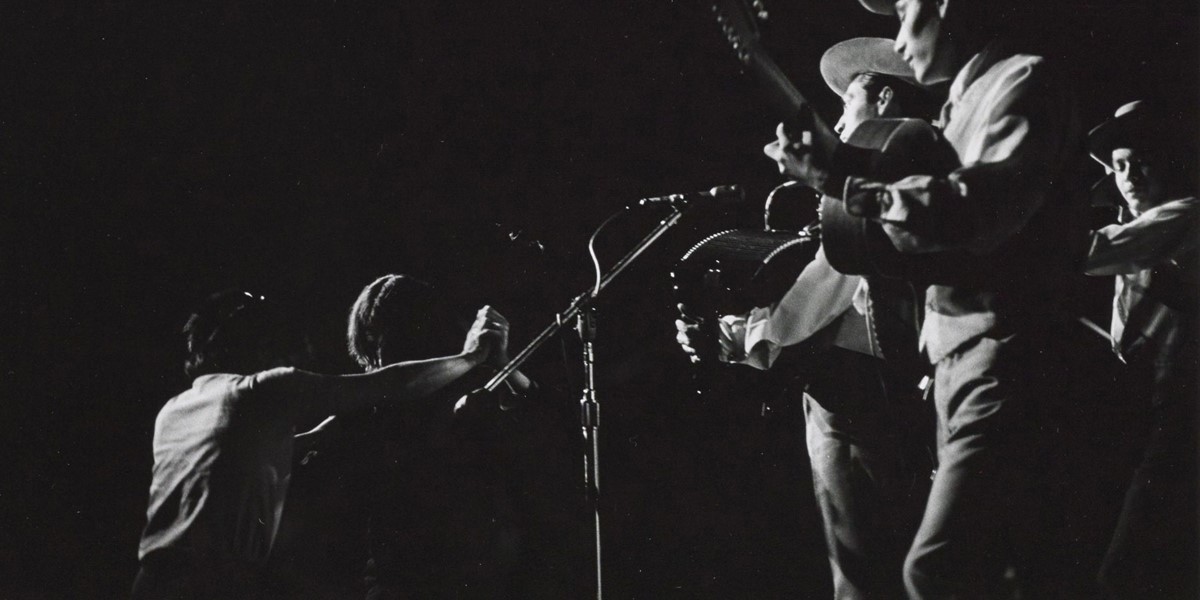Wednesday, March 27, 2024
Los Tigres del Norte | Fireside Stories
Los Tigres del Norte emerged in the 1960s with a new take on Mexican storytelling. Their tales of migration and hardship have become increasingly relevant with every passing year

Los Tigres del Norte performing at Berkeley Folk Music Festival, 1970 (John Melville Bishop © Northwestern University. Courtesy Berkeley Folk Music Festival Archive)
The world of Los Tigres del Norte is one where death is the punchline and betrayal emerges as the only option for survival. They are not the most obvious themes for a group to win over the world with, but that’s exactly what Los Tigres have achieved, becoming the Mexican group inside and outside their homeland with corridos full of drama and romance led by fearless characters with big hearts and some bad friends.
Corridos are story songs or narrative ballads, with the oldest known being written in 1811 in Zacatecas. When Los Tigres del Norte began releasing music in 1968, the so-called ‘golden era of the recorded corrido’ (1928-1937) was well and truly over, and soon a new variant on the style would emerge that angered the purists. Luis, the youngest of the Hernández brothers to join Los Tigres del Norte (he did so in 1996), talks about the group’s beginnings and first hit: “‘Camelia’ [the colloquial name for 1973’s ‘Contrabando y Traición’] took Los Tigres to the next level, it was recorded here in San José, California, and was mostly played and sold at flea markets, known in Mexico as tianguis.” ‘Contrabando y Traición’ tells the story of Emilio and Camelia La Tejana who journey together from Mexico through the US border with a large amount of marijuana, delivering it successfully in Los Angeles. Once there, Emilio tells Camelia he’s leaving her for his true love. It doesn’t end well. Camelia shoots him seven times and runs away with the money.
Luis says that Los Tigres broke into the US market through artisanal means: “Arthur Walker, producer of Los Tigres, also took on the duties of pressman for ‘Camelia’ and that work was done mostly hand to hand, that’s why it started winning people over and got the group offers to play in San Diego and then out of state. Los Tigres first became successful in the United States and then in Mexico, something rather unusual. We are always surprised when we play the song live because everybody sings it, from children to older people. Women sing it louder, because they feel empowered through the main character.”
Luis’ first encounter with Los Tigres was at the movies: “My first memory related to Los Tigres del Norte is hearing ‘La Banda del Carro Rojo’ [which] was made into a movie. I am the youngest in the family, so my mamma took me to see it… I was nervous to see my brothers in a motion picture.”
The Hernández brothers started playing music together in Sinaloa, Mexico when their father woke up one day in 1965 and couldn’t move his legs due to nerve problems. The brothers, along with their cousin Óscar Lara, started playing music to raise funds for an operation. One day they were propositioned to play in a prison north of the border. On the way a migration officer, asking for their artistic name, christened them Los Tigritos (the little tigers) because he thought they would be big. He changed it to Los Tigres (the tigers) when he reasoned they would grow up one day. Del Norte was added purely as they were heading north.
When Luis asked his brothers about Los Tigres’ first big show, they remembered one in California: “When my brothers talk about this subject, there is a show done in Berkeley, a big festival [the Berkeley Folk Music Festival, 1970]. That was the first time they felt the response of a huge audience singing and dancing to their original tunes. I think that type of experience pushed them to keep at it.”
If Los Tigres are an authoritative voice for stories around migration into the US, that’s because they’ve experienced it: “We have all been in the US with an illegal migration status at some point,” says Luis. “I came as a student, but my visa expired. I never made the trip across the border without papers, but we know that border perfectly. All of us brothers have stories to tell about the people that make that journey into this country, in search of the American Dream and to help those back home. We know perfectly the necessities of our people in the US and we are realising that Europe has had the same complication… The border has many stories from so many friends, some are known as ‘polleros’, others as ‘coyotes’ [names given to those who facilitate people smuggling]. We know all kinds of people and that’s the roots of our songs. Because of our experiences, we can deliver the message.”
Even though the group was formed over half a century ago, social issues raised by Los Tigres, especially those related to how migrants are treated when they enter the US, keep repeating: “A song like ‘Camelia’ mentions she had drugs in the wheels of her car, and that is still going on. If a migrant crosses the border they will likely check the wheels of your vehicle… Real subjects never go out of fashion.”
As told by Hernan Muleiro
Los Tigres del Norte will play at the Eventim Apollo, London on April 14 as part of La Linea 24: comono.co.uk
This article originally appeared in the April 2024 issue of Songlines. Never miss an issue – subscribe today

